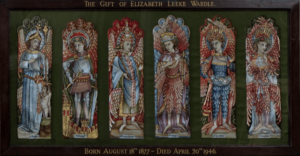Leek Embroidery Society facts for kids
 |
|
| Industry | Embroidery |
|---|---|
| Founded | 1879 |
| Founder | Thomas and Elizabeth Wardle |
|
Area served
|
Leek, Staffordshire |
| Products | Bayeux Tapestry Replica |
The Leek Embroidery Society was started in 1879 in Leek, Staffordshire. It became famous for making beautiful embroidery for homes and churches. Their work won important awards because it was so fine and high quality.
The Society also created a special type of embroidery using tussar silk. Their goal was to encourage artistic embroidery and fine needlework. Their amazing pieces were shown in many exhibitions around the world. The Leek Embroidery Society even helped start the Leek School of Art Embroidery.
Contents
History of the Society
The 1870s: A New Style of Embroidery
In the 1870s, a new style called Art Needlework became popular in Britain. This was a different way of doing embroidery. It was a reaction against Berlin wool work, which was very simple and repetitive.
Art Needlework focused on more creative and skilled designs. Groups like the Leek Embroidery Society wanted to make embroidery better. They also wanted to help women earn a living through their needlework skills.
The 1880s: Founding and Growth
The Leek Embroidery Society began in 1879. It was first called the Leek Sewing Circle. It was founded by Thomas Wardle and his wife, Elizabeth Wardle. Thomas was a silk dyer who later became a knight. Elizabeth was a very talented embroiderer.
Thomas wanted to expand his silk business. He gave Elizabeth tussar silk from India. He asked her to create a new embroidery style using it. Elizabeth developed a special way to use this silk. This led to the start of the Leek Embroidery Society.
Elizabeth was a big fan of Art Needlework. She wanted the Society to promote this artistic style. She was inspired by famous artists like William Morris. Morris worked with Thomas Wardle on natural dyes. The Society's work was a great example of the Arts and Crafts movement.
In 1881, the Society held an exhibition at the Leek Art School. The director of the Victoria and Albert Museum even gave out prizes. The exhibition showed their church embroidery and other pieces for homes. Other famous groups, like Morris & Company, also sent their work. This showed that Art Needlework was a real art form.
The Leek embroiderers often used tussar silk floss. This silk was dyed with Thomas Wardle's natural dyes. They used it on woven silk for church items. For home items, they used it on hand-blocked silk. They also used gold thread from Japan. The Leek embroidery style was known for its beautiful designs and bright, rich silk colors.
In 1883, a shop was opened in Bond Street in London. Later, items were sold through other agencies. There was also a shop in Leek, near the Wardles' home. They sold things for the home, like cushions and drapes.
The Famous Bayeux Tapestry Replica
By 1885, thirty-seven women from the Society started a huge project. They began making a copy of the famous Bayeux Tapestry. Elizabeth Wardle had seen the real tapestry. She believed Britain should have its own version.
The replica took one year to complete. It was shown all over Britain, the United States, and Germany. In 1895, it found its permanent home at Reading Museum. This replica is the most famous work made by the Leek Embroidery Society. You can learn more about the original Bayeux Tapestry online.
The 1890s and Beyond
The Society's work was very popular until about 1900. Their items were sold in Wardle's shop in London. They were also sold in William Morris's shop and at Liberty & Co.
Elizabeth Wardle passed away in 1902. After that, the Society's production quickly slowed down. Products with the Society's designs were still sold in the Leek shop. This shop finally closed in the 1930s.
Images for kids


